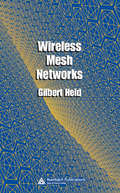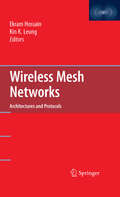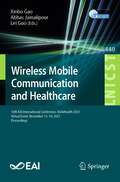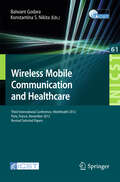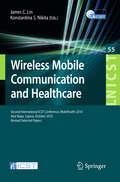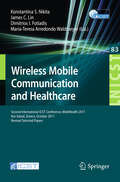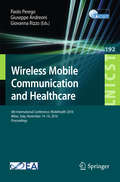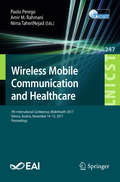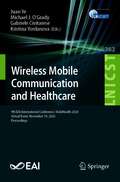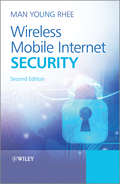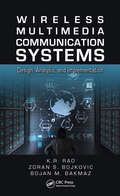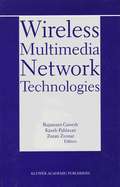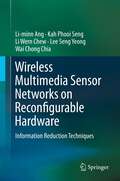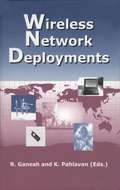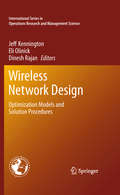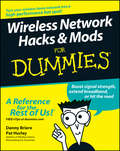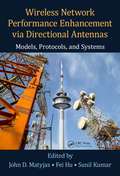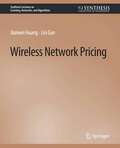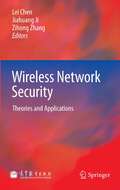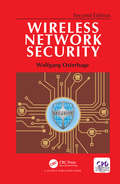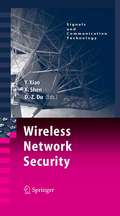- Table View
- List View
Wireless Mesh Networks
by Gilbert HeldWireless mesh networking is a new technology that has the potential to revolutionize how we access the Internet and communicate with co-workers and friends. Wireless Mesh Networks examines the concept and explores its advantages over existing technologies. This book explores existing and future applications, and examines how some of the networking
Wireless Mesh Networks
by Gilbert HeldWireless mesh networking is a new technology that has the potential to revolutionize how we access the Internet and communicate with co-workers and friends. Wireless Mesh Networks examines the concept and explores its advantages over existing technologies. This book explores existing and future applications, and examines how some of the networking
Wireless Mesh Networks: Architectures and Protocols
by Ekram Hossain Kin K. LeungThis book collects articles featuring recent advances in the theory and applications of wireless mesh networking technology. The contributed articles, from the leading experts in the field, cover both theoretical concepts and system-level implementation issues. The book starts with the essential background on the basic concepts and architectures of wireless mesh networking and then presents advanced level materials in a step-by-step fashion.
Wireless Mobile Communication and Healthcare: 10th EAI International Conference, MobiHealth 2021, Virtual Event, November 13–14, 2021, Proceedings (Lecture Notes of the Institute for Computer Sciences, Social Informatics and Telecommunications Engineering #440)
by Xinbo Gao Abbas Jamalipour Lei GuoThis book constitutes the refereed post-conference proceedings of the 10th International Conference on Mobile Communication and Healthcare, MobiHealth 2021, held in November 2021. Due to Covid-19 pandemic the conference was held virtually.
Wireless Mobile Communication and Healthcare: Third International Conference, MobiHealth 2012, Paris, France, November 21-23, 2012, Revised Selected Papers (Lecture Notes of the Institute for Computer Sciences, Social Informatics and Telecommunications Engineering #61)
by Balwant Godara Konstantina S. NikitaThis book constitutes the refereed proceedings of the Third International Conference on Wireless Mobile Communication and Healthcare, MobiHealth 2012, and of the two workshops: Workshop on Advances in Personalized Healthcare Services, Wearable Mobile Monitoring, and Social Media Pervasive Technologies (APHS 2012), and Workshop on Advances in Wireless Physical Layer Communications for Emerging Healthcare Applications (IWAWPLC 2012), all held in Paris, France, in November 2012. The 39 revised full papers presented were carefully reviewed and selected from 66 submissions. The papers are organized in topical sections covering wearable, outdoor and home-based applications; remote diagnosis and patient management; data processing; sensor devices and systems; biomedical monitoring in relation to society and the environment; body area networks; telemedicine systems for disease-specific applications; data collection and management; papers from the invited session "Implants"; papers from the IWAWPLC and APHS workshops.
Wireless Mobile Communication and Healthcare: Second International ICST Conference, MobiHealth 2010, Ayia Napa, Cyprus, October 18 - 20, 2010, Revised Selected Papers (Lecture Notes of the Institute for Computer Sciences, Social Informatics and Telecommunications Engineering #55)
by James C. Lin Konstantina S. NikitaThis book contains a selection of thoroughly refereed and revised papers from the Second International ICST Conference on Wireless and Mobile Communication in Healthcare, MobiHealth 2010, held in Ayia Napa, Cyprus, in October 2010. The 33 papers in this volume describe various applications of information and communication technologies in healthcare and medicine and cover a wide range of topics such as intelligent public health monitoring services, mobile health technologies, signal processing techniques for monitoring services, wearable biomedical devices, ambient assistive technologies, emergency and disaster applications, and integrated systems for chronic monitoring and management.
Wireless Mobile Communication and Healthcare: Second International ICST Conference, MobiHealth 2011, Kos Island, Greece, October 5-7, 2011. Revised Selected Papers (Lecture Notes of the Institute for Computer Sciences, Social Informatics and Telecommunications Engineering #83)
by Konstantina S. Nikita James C. Lin Dimitrios I. Fotiadis Maria-Teresa Arredondo WaldmeyerThis book constitutes the refereed proceedings of the Second International ICST Conference on Wireless Mobile Communication and Healthcare, MobiHealth 2011, held on Kos Island, Greece, in October 2011. The 60 revised full papers presented were carefully reviewed and selected from more than 80 submissions. The papers are organized in 10 sessions and two workshops with topics covering intrabody communications, chronic disease monitoring and management, ambient assistive technologies, implantable and wearable sensors, emergency and disaster applications.
Wireless Mobile Communication and Healthcare: 6th International Conference, MobiHealth 2016, Milan, Italy, November 14-16, 2016, Proceedings (Lecture Notes of the Institute for Computer Sciences, Social Informatics and Telecommunications Engineering #192)
by Paolo Perego Giuseppe Andreoni Giovanna RizzoThis book constitutes the refereed post-conference proceedings of the 6th International Conference on Mobile Communication and Healthcare, MobiHealth 2016, held in Milan, Italy, in November 2016. The 50 revised full papers were reviewed and selected from numerous submissions and are organized in topical sections covering: Technological development for m-health application user engagement.- IoT - Internet of Things.- Advances in soft wearable technology for mobile-health.- Emerging experiences into receiving and delivering healthcare through mobile and embedded solutions.- Advances in personalized healthcare services.- Mobile monitoring, and social media pervasive technologies.
Wireless Mobile Communication and Healthcare: 7th International Conference, MobiHealth 2017, Vienna, Austria, November 14–15, 2017, Proceedings (Lecture Notes of the Institute for Computer Sciences, Social Informatics and Telecommunications Engineering #247)
by Paolo Perego Amir M. Rahmani Nima TaheriNejadThis book constitutes the refereed post-conference proceedings of the 7th International Conference on Mobile Communication and Healthcare, MobiHealth 2017, held in Vienna, Austria, in November 2017. The 34 revised full papers were reviewed and selected from more than 50 submissions and are organized in topical sections covering data analysis, systems, work-in-process, pervasive and wearable health monitoring, advances in healthcare services, design for healthcare, advances in soft wearable technology for mobile-health, sensors and circuits.
Wireless Mobile Communication and Healthcare: 9th EAI International Conference, MobiHealth 2020, Virtual Event, November 19, 2020, Proceedings (Lecture Notes of the Institute for Computer Sciences, Social Informatics and Telecommunications Engineering #362)
by Juan Ye Michael J. O’Grady Gabriele Civitarese Kristina YordanovaThis book constitutes the refereed post-conference proceedings of the 9th International Conference on Mobile Communication and Healthcare, MobiHealth 2020, held in December 2020. Due to Covid-19 pandemic the conference was held virtually. The book contains 13 full papers selected from the main conference and 10 full papers from two workshops on medical artificial intelligence and on digital healthcare technologies. The conference papers are organized in topical sections on wearable technologies; health telemetry; mobile sensing and assessment; machine learning in eHealth applications.
Wireless Mobile Internet Security
by Man Young RheeThe mobile industry for wireless cellular services has grown at a rapid pace over the past decade. Similarly, Internet service technology has also made dramatic growth through the World Wide Web with a wire line infrastructure. Realization for complete wired/wireless mobile Internet technologies will become the future objectives for convergence of these technologies through multiple enhancements of both cellular mobile systems and Internet interoperability. Flawless integration between these two wired/wireless networks will enable subscribers to not only roam worldwide, but also to solve the ever increasing demand for data/Internet services. In order to keep up with this noteworthy growth in the demand for wireless broadband, new technologies and structural architectures are needed to greatly improve system performance and network scalability while significantly reducing the cost of equipment and deployment. Dr. Rhee covers the technological development of wired/wireless internet communications in compliance with each iterative generation up to 4G systems, with emphasis on wireless security aspects. By progressing in a systematic matter, presenting the theory and practice of wired/wireless mobile technologies along with various security problems, readers will gain an intimate sense of how mobile internet systems operate and how to address complex security issues. Features: Written by a top expert in information security Gives a clear understanding of wired/wireless mobile internet technologies Presents complete coverage of various cryptographic protocols and specifications needed for 3GPP: AES, KASUMI, Public-key and Elliptic curve cryptography Forecast new features and promising 4G packet-switched wireless internet technologies for voice and data communications Provides MIMO/OFDMA-based for 4G systems such as Long Term Evolution (LTE), Ultra Mobile Broadband (UMB), Mobile WiMax or Wireless Broadband (WiBro) Deals with Intrusion Detection System against worm/virus cyber attacks The book ideal for advanced undergraduate and postgraduate students enrolled in courses such as Wireless Access Networking, Mobile Internet Radio Communications. Practicing engineers in industry and research scientists can use the book as a reference to get reacquainted with mobile radio fundamentals or to gain deeper understanding of complex security issues.
Wireless Mobile Internet Security
by Man Young RheeThe mobile industry for wireless cellular services has grown at a rapid pace over the past decade. Similarly, Internet service technology has also made dramatic growth through the World Wide Web with a wire line infrastructure. Realization for complete wired/wireless mobile Internet technologies will become the future objectives for convergence of these technologies through multiple enhancements of both cellular mobile systems and Internet interoperability. Flawless integration between these two wired/wireless networks will enable subscribers to not only roam worldwide, but also to solve the ever increasing demand for data/Internet services. In order to keep up with this noteworthy growth in the demand for wireless broadband, new technologies and structural architectures are needed to greatly improve system performance and network scalability while significantly reducing the cost of equipment and deployment. Dr. Rhee covers the technological development of wired/wireless internet communications in compliance with each iterative generation up to 4G systems, with emphasis on wireless security aspects. By progressing in a systematic matter, presenting the theory and practice of wired/wireless mobile technologies along with various security problems, readers will gain an intimate sense of how mobile internet systems operate and how to address complex security issues. Features: Written by a top expert in information security Gives a clear understanding of wired/wireless mobile internet technologies Presents complete coverage of various cryptographic protocols and specifications needed for 3GPP: AES, KASUMI, Public-key and Elliptic curve cryptography Forecast new features and promising 4G packet-switched wireless internet technologies for voice and data communications Provides MIMO/OFDMA-based for 4G systems such as Long Term Evolution (LTE), Ultra Mobile Broadband (UMB), Mobile WiMax or Wireless Broadband (WiBro) Deals with Intrusion Detection System against worm/virus cyber attacks The book ideal for advanced undergraduate and postgraduate students enrolled in courses such as Wireless Access Networking, Mobile Internet Radio Communications. Practicing engineers in industry and research scientists can use the book as a reference to get reacquainted with mobile radio fundamentals or to gain deeper understanding of complex security issues.
Wireless Multimedia Communication Systems: Design, Analysis, and Implementation
by K.R. Rao Zoran S. Bojkovic Bojan M. BakmazRapid progress in software, hardware, mobile networks, and the potential of interactive media poses many questions for researchers, manufacturers, and operators of wireless multimedia communication systems. Wireless Multimedia Communication Systems: Design, Analysis, and Implementation strives to answer those questions by not only covering the underlying concepts involved in the design, analysis, and implementation of wireless multimedia communication systems, but also by tackling advanced topics such as mobility management, security components, and smart grids. Offering an accessible treatment of the latest research, this book: Presents specific wireless multimedia communication schemes that have proven to be useful Discusses important standardization processing activities regarding wireless networking Includes wireless mesh and multimedia sensor network architectures, protocols, and design optimizations Highlights the challenges associated with meeting complex connectivity requirements Contains numerous figures, tables, examples, references, and a glossary of acronyms Providing coverage of significant technological advances in their initial steps along with a survey of the fundamental principles and practices, Wireless Multimedia Communication Systems: Design, Analysis, and Implementation aids senior-level and graduate-level engineering students and practicing professionals in understanding the processes and furthering the development of today’s wireless multimedia communication systems.
Wireless Multimedia Communication Systems: Design, Analysis, and Implementation
by K.R. Rao Zoran S. Bojkovic Bojan M. BakmazRapid progress in software, hardware, mobile networks, and the potential of interactive media poses many questions for researchers, manufacturers, and operators of wireless multimedia communication systems. Wireless Multimedia Communication Systems: Design, Analysis, and Implementation strives to answer those questions by not only covering the underlying concepts involved in the design, analysis, and implementation of wireless multimedia communication systems, but also by tackling advanced topics such as mobility management, security components, and smart grids. Offering an accessible treatment of the latest research, this book: Presents specific wireless multimedia communication schemes that have proven to be useful Discusses important standardization processing activities regarding wireless networking Includes wireless mesh and multimedia sensor network architectures, protocols, and design optimizations Highlights the challenges associated with meeting complex connectivity requirements Contains numerous figures, tables, examples, references, and a glossary of acronyms Providing coverage of significant technological advances in their initial steps along with a survey of the fundamental principles and practices, Wireless Multimedia Communication Systems: Design, Analysis, and Implementation aids senior-level and graduate-level engineering students and practicing professionals in understanding the processes and furthering the development of today’s wireless multimedia communication systems.
Wireless Multimedia Network Technologies (The Springer International Series in Engineering and Computer Science #524)
by Rajamani Ganesh Kaveh Pahlavan Zoran ZvonarThis book is a collection of invited papers that were presented at the Ninth IEEE International Symposium on Personal, Indoor and Mobile Radio Communications, September 5-8, 1998, Boston, MA. These papers are meant to provide a global view of the emerging third-generation wireless networks in the wake of the third millennium. Following the tradition of the PIMRC conferences, the papers are selected to strike a balance between the diverse interests of academia and industry by addressing issues of interest to the designers, manufacturers, and service providers involved in the wireless networking industry. The tradition of publishing a collection of the invited papers presented at the PIMRC started in PIMRC’97, Helsinki, Finland. There are two benefits to this tradition (1) it provides a shorter version of the proceedings of the conference that is more focused on a specific theme (2) the papers are comprehensive and are subject of a more careful review process to improve the contents as well as the presentation of the material, making it more appealing for archival as a reference book. The production costs of the book is subsidized by the conference and the editors have donated the royalty income of the book to the conference.
Wireless Multimedia Sensor Networks on Reconfigurable Hardware: Information Reduction Techniques
by Li-minn Ang Kah Phooi Seng Li Wern Chew Lee Seng Yeong Wai Chong ChiaTraditional wireless sensor networks (WSNs) capture scalar data such as temperature, vibration, pressure, or humidity. Motivated by the success of WSNs and also with the emergence of new technology in the form of low-cost image sensors, researchers have proposed combining image and audio sensors with WSNs to form wireless multimedia sensor networks (WMSNs). This introduces practical and research challenges, because multimedia sensors, particularly image sensors, generate huge amounts of data to be processed and distributed within the network, while sensor nodes have restricted battery power and hardware resources. This book describes how reconfigurable hardware technologies such as field-programmable gate arrays (FPGAs) offer cost-effective, flexible platforms for implementing WMSNs, with a main focus on developing efficient algorithms and architectures for information reduction, including event detection, event compression, and multicamera processing for hardware implementations. The authors include a comprehensive review of wireless multimedia sensor networks, a complete specification of a very low-complexity, low-memory FPGA WMSN node processor, and several case studies that illustrate information reduction algorithms for visual event compression, detection, and fusion. The book will be of interest to academic researchers, R&D engineers, and computer science and engineering graduate students engaged with signal and video processing, computer vision, embedded systems, and sensor networks.
Wireless Network Deployments (The Springer International Series in Engineering and Computer Science #558)
by Rajamani Ganesh Kaveh PahlavanAn important aspect of wireless networks is the deployment of their infrastructure. In this book, the Editors have invited a number of experts from industry to write on a variety of topics associated with deployment of digital wireless networks. The first part of the book consists of an overview of systems design and engineering integration, comparison of polarization and space diversity antenna systems, and the performance of deploying smart antenna architectures in cellular and PCS networks. The second part addresses deployment of CDMA networks, based on IS-95 standards. Here the authors discuss issues related to optimization of overlaid dual model CDMA networks, embedding microcells to improve hot-spot capacity, and mitigation of intermodulation distortion in handsets. Part III deals with deployment of TDMA- based networks. The issues presented include developing hierarchical systems, reconfigurable transceivers, and deploying the GSM frequency hopping feature for enhancing existing traffic capacity. The last part, on Wireless Data Networks, is comprised of issues related to the performance of GPRS systems deployed as an upgrade on current networks and deployment of wireless LANs. Critical issues for deploying an IEEE 802.11-based WLAN are examined. Wireless Network Deployments provides practical engineering guidance for wireless and cellular engineers, researchers, technicians, and managers working in second and third generation digital wireless networks.
Wireless Network Design: Optimization Models and Solution Procedures (International Series in Operations Research & Management Science #158)
by Jeff Kennington Eli Olinick Dinesh RajanThis book surveys state-of-the-art optimization modeling for design, analysis, and management of wireless networks, such as cellular and wireless local area networks (LANs), and the services they deliver. The past two decades have seen a tremendous growth in the deployment and use of wireless networks. The current-generation wireless systems can provide mobile users with high-speed data services at rates substantially higher than those of the previous generation. As a result, the demand for mobile information services with high reliability, fast response times, and ubiquitous connectivity continues to increase rapidly. The optimization of system performance has become critically important both in terms of practical utility and commercial viability, and presents a rich area for research. In the editors' previous work on traditional wired networks, we have observed that designing low cost, survivable telecommunication networks involves extremely complicated processes. Commercial products available to help with this task typically have been based on simulation and/or proprietary heuristics. As demonstrated in this book, however, mathematical programming deserves a prominent place in the designer's toolkit. Convenient modeling languages and powerful optimization solvers have greatly facilitated the implementation of mathematical programming theory into the practice of commercial network design.These points are equally relevant and applicable in today’s world of wireless network technology and design. But there are new issues as well: many wireless network design decisions, such as routing and facility/element location, must be dealt with in innovative ways that are unique and distinct from wired (fiber optic) networks. The book specifically treats the recent research and the use of modeling languages and network optimization techniques that are playing particularly important and distinctive roles in the wireless domain.
Wireless Network Hacks and Mods For Dummies
by Danny Briere Pat HurleyFun projects and valuable content join forces to enable readers to turn their wireless home network into a high-performance wireless infrastructure capable of entertainment networking and even home automation Step-by-step instructions help readers find, buy, and install the latest and greatest wireless equipment The authors are home tech gurus and offer detailed discussion on the next-generation wireless gear that will move the wireless LAN beyond computers and into telephony, entertainment, home automation/control, and even automotive networking The number of wireless LAN users in North America is expected to grow from 4.2 million current users to more than 31 million by 2007
Wireless Network Performance Enhancement via Directional Antennas: Models, Protocols, and Systems
by John D. Matyjas Fei Hu Sunil KumarDirectional antenna technologies have made significant advancements in the last decade. These advances have opened the door to many exciting new design opportunities for wireless networks to enhance quality of service (QoS), performance, and network capacity. In this book, experts from around the world present the latest research and development in
Wireless Network Pricing (Synthesis Lectures on Learning, Networks, and Algorithms)
by Jianwei Huang Lin GaoToday's wireless communications and networking practices are tightly coupled with economic considerations, to the extent that it is almost impossible to make a sound technology choice without understanding the corresponding economic implications. This book aims at providing a foundational introduction on how microeconomics, and pricing theory in particular, can help us to understand and build better wireless networks. The book can be used as lecture notes for a course in the field of network economics, or a reference book for wireless engineers and applied economists to understand how pricing mechanisms influence the fast growing modern wireless industry. This book first covers the basics of wireless communication technologies and microeconomics, before going in-depth about several pricing models and their wireless applications. The pricing models include social optimal pricing, monopoly pricing, price differentiation, oligopoly pricing, and network externalities, supported by introductory discussions of convex optimization and game theory. The wireless applications include wireless video streaming, service provider competitions, cellular usage-based pricing, network partial price differentiation, wireless spectrum leasing, distributed power control, and cellular technology upgrade. More information related to the book (including references, slides, and videos) can be found at ncel.ie.cuhk.edu.hk/content/wireless-network-pricing.
Wireless Network Security: Theories and Applications
by Lei Chen Jiahuang Ji Zihong ZhangWireless Network Security Theories and Applications discusses the relevant security technologies, vulnerabilities, and potential threats, and introduces the corresponding security standards and protocols, as well as provides solutions to security concerns. Authors of each chapter in this book, mostly top researchers in relevant research fields in the U.S. and China, presented their research findings and results about the security of the following types of wireless networks: Wireless Cellular Networks, Wireless Local Area Networks (WLANs), Wireless Metropolitan Area Networks (WMANs), Bluetooth Networks and Communications, Vehicular Ad Hoc Networks (VANETs), Wireless Sensor Networks (WSNs), Wireless Mesh Networks (WMNs), and Radio Frequency Identification (RFID). The audience of this book may include professors, researchers, graduate students, and professionals in the areas of Wireless Networks, Network Security and Information Security, Information Privacy and Assurance, as well as Digital Forensics.Lei Chen is an Assistant Professor at Sam Houston State University, USA; Jiahuang Ji is an Associate Professor at Sam Houston State University, USA; Zihong Zhang is a Sr. software engineer at Jacobs Technology, USA under NASA contract.
Wireless Network Security: Second Edition
by Wolfgang OsterhageWireless communications have become indispensable part of our lives. The book deals with the security of such wireless communication. The technological background of these applications have been presented in detail. Special emphasis has been laid on the IEEE 802.11x-standards that have been developed for this technology. A major part of the book is devoted to security risks, encryption and authentication. Checklists have been provided to help IT administrators and security officers to achieve the maximum possible security in their installations, when using wireless technology. This is the second edition of the book. The updates include the latest the IEEE 802.11-standard, an updated chapter on PDA, the increased relevance of smart phones and tablets, widespread use of WLAN with increased security risks.
Wireless Network Security: Second Edition
by Wolfgang OsterhageWireless communications have become indispensable part of our lives. The book deals with the security of such wireless communication. The technological background of these applications have been presented in detail. Special emphasis has been laid on the IEEE 802.11x-standards that have been developed for this technology. A major part of the book is devoted to security risks, encryption and authentication. Checklists have been provided to help IT administrators and security officers to achieve the maximum possible security in their installations, when using wireless technology. This is the second edition of the book. The updates include the latest the IEEE 802.11-standard, an updated chapter on PDA, the increased relevance of smart phones and tablets, widespread use of WLAN with increased security risks.
Wireless Network Security (Signals and Communication Technology)
by Yang Xiao Ding-Zhu Du Xuemin ShenThis book identifies vulnerabilities in the physical layer, the MAC layer, the IP layer, the transport layer, and the application layer, of wireless networks, and discusses ways to strengthen security mechanisms and services. Topics covered include intrusion detection, secure PHY/MAC/routing protocols, attacks and prevention, immunization, key management, secure group communications and multicast, secure location services, monitoring and surveillance, anonymity, privacy, trust establishment/management, redundancy and security, and dependable wireless networking.
